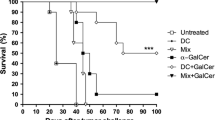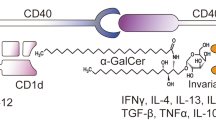Abstract
A unique lymphocyte population, Vα14 NKT cells, has recently been revealed to be a key player in the immune responses against tumors. Activation of Vα14 NKT cells affects various cell types, particularly dendritic cells (DCs), NK cells, CD4 Th1 cells, and CD8 cytotoxic T cells in the innate and acquired immune systems, eventually resulting in the enhanced activation of NKT cell-mediated cellular cascade in the anti-tumor responses. The specific ligand, α-galactosylceramide (α-GalCer), effectively stimulates mouse and human NKT cells, making NKT cells an ideal target for the development of cancer immunotherapy. Clinical trials using α-GalCer have actually started in several centers in the world. In this review, we summarize the Vα14 NKT cell-mediated cellular cascade in the anti-tumor response in mice and discuss potential clinical applications of α-GalCer-pulsed DC therapy.

Similar content being viewed by others
References
Taniguchi M, Harada M, Kojo S, et al (2003) The regulatory role of Vα14NKT cells in innate and acquired immune response. Annu Rev Immunol 21:483
Kawano T, Cui J, Koezuka Y, et al (1997) CD1d-restricted and TCR-mediated activation of Vα14 NKT cells by glycosylceramides. Science 278:1626
Bendelac A, Lantz O, Quimby ME, et al (1995) CD1 recognition by mouse NK1+ T lymphocytes. Science 268:863
Kawano T, Cui J, Koezuka Y, et al (1998) Natural killer-like nonspecific tumor cell lysis mediated by specific ligand-activated Vα14 NKT cells. Proc Natl Acad Sci USA 95:5690
Nieda M, Nicol A, Koezuka Y, et al (2001) TRAIL expression by activated human CD4+Vα24NKT cells induces in vitro and in vivo apoptosis of human acute myeloid leukemia cells. Blood 97:2067
Nakagawa R, Nagafune I, Tazunoki Y, et al (2001) Mechanisms of the antimetastatic effect in the liver and of the hepatocyte injury induced by α-galactosylceramide in mice. J Immunol 166:6578
Brigl M, Bry L, Kent SC, et al (2003) Mechanism of CD1d-restricted natural killer T cell activation during microbial infection. Nat Immunol 4:1230
Gumperz JE, Roy C, Makowska A, et al (2000) Murine CD1d-restricted T cell recognition of cellular lipids. Immunity 12:211
Kawano T, Nakayama T, Kamada N, et al (1999) Antitumor cytotoxicity mediated by ligand-activated human Vα24 NKT cells. Cancer Res 59:5102
Zhou D, Cantu C 3rd, Sagiv Y, et al (2004) Editing of CD1d-bound lipid antigens by endosomal lipid transfer proteins. Science 303:523
Kamada N, Iijima H, Kimura K, et al (2001) Crucial amino acid residues of mouse CD1d for glycolipid ligand presentation to V(α)14 NKT cells. Int Immunol 13:853
Kitamura H, Iwakabe K, Yahata T, et al (1999) The natural killer T (NKT) cell ligand α-galactosylceramide demonstrates its immunopotentiating effect by inducing interleukin IL-12 production by dendritic cells and IL-12 receptor expression on NKT cells. J Exp Med 189:1121
Tomura M, Yu WG, Ahn HJ, et al (1999) A novel function of Vα14+CD4+NKT cells: stimulation of IL-12 production by antigen-presenting cells in the innate immune system. J Immunol 163:93
Smyth MJ, Crowe NY, Pellicci DG, et al (2002) Sequential production of interferon-gamma by NK1.1+T cells and natural killer cells is essential for the antimetastatic effect of α-galactosylceramide. Blood 99:1259
Hayakawa Y, Takeda K, Yagita H, et al (2001) Critical contribution of IFN-gamma and NK cells, but not perforin-mediated cytotoxicity, to anti-metastatic effect of α-galactosylceramide. Eur J Immunol 31:1720
Smyth MJ, Cretney E, Takeda K, et al (2001) Tumor necrosis factor-related apoptosis-inducing ligand (TRAIL) contributes to interferon gamma-dependent natural killer cell protection from tumor metastasis. J Exp Med 193:661
Vilches C, Parham P (2002) KIR: diverse, rapidly evolving receptors of innate and adaptive immunity. Annu Rev Immunol 20:217
Natarajan K, Dimasi N, Wang J, et al (2002) Structure and function of natural killer cell receptors: multiple molecular solutions to self, nonself discrimination. Annu Rev Immunol 20:853
Maeda M, Lohwasser S, Yamamura T, et al (2001) Regulation of NKT cells by Ly49: analysis of primary NKT cells and generation of NKT cell line. J Immunol 167:4180
Chang CS, Brossay L, Kronenberg M, et al (1999) The murine nonclassical class I major histocompatibility complex-like CD1.1 molecule protects target cells from lymphokine-activated killer cell cytolysis. J Exp Med 189:483
Dhodapkar MV, Geller MD, Chang DH, et al (2003) A reversible defect in natural killer T cell function characterizes the progression of premalignant to malignant multiple myeloma. J Exp Med 197:1667
Metelitsa LS, Naidenko OV, Kant A, et al (2001) Human NKT cells mediate antitumor cytotoxicity directly by recognizing target cell CD1d with bound ligand or indirectly by producing IL-2 to activate NK cells. J Immunol 167:3114
Nicol A, Nieda M, Koezuka Y, et al (2000) Human invariant vα24+ natural killer T cells activated by α-galactosylceramide (KRN7000) have cytotoxic anti-tumour activity through mechanisms distinct from T cells and natural killer cells. Immunology 99:229
Azuma T, Takahashi T, Kunisato A, et al (2003) Human CD4+ CD25+ regulatory T cells suppress NKT cell functions. Cancer Res 63:4516
Nishikawa H, Kato T, Tanida K, et al (2003) CD4+ CD25+ T cells responding to serologically defined autoantigens suppress antitumor immune responses. Proc Natl Acad Sci USA 100:10902
Kronenberg M, Gapin L (2002) The unconventional lifestyle of NKT cells. Nat Rev Immunol 2:557
Terabe M, Matsui S, Noben-Trauth N, et al (2003) TGF-beta production and myeloid cell are an effector mechanism through which CD1d-restricted T cells block CTL-mediated tumor immunosurveillance: abrogation prevents tumor recurrence. J Exp Med 198:1741
Terabe M, Matsui S, Noben-Trauth N, et al (2000) NKT cell-mediated repression of tumor immunosurveillance by IL-13 and the IL-4R-STAT6 pathway. Nat Immunol 1:515
Terabe M, Berzofsky JA (2004) Immunoregulatory T cells in tumor immunity. Curr Opin Immunol 16:157
Rogers PR, Matsumoto A, Naidenko O, et al (2004) Expansion of human Vα24+ NKT cells by repeated stimulation with KRN7000. J Immunol Methods 285:197
Vliet HJ van der, Nishi N, Koezuka Y, et al (2001) Potent expansion of human natural killer T cells using α-galactosylceramide (KRN7000)-loaded monocyte-derived dendritic cells, cultured in the presence of IL-7 and IL-15. J Immunol Methods 247:61
Takahashi T, Nieda M, Koezuka Y, et al (2000) Analysis of human V α 24+ CD4+ NKT cells activated by α-glycosylceramide-pulsed monocyte-derived dendritic cells. J Immunol 164:4458
Gumperz JE, Miyake S, Yamamura T, et al (2002) Functionally distinct subsets of CD1d-restricted natural killer T cells revealed by CD1d tetramer staining. J Exp Med 195:625
Motohashi S, Kobayashi S, Ito T, et al (2002) Preserved IFN-gamma production of circulating Vα24 NKT cells in primary lung cancer patients. Int J Cancer 102:159
Tahir SM, Cheng O, Shaulov A, et al (2001) Loss of IFN-gamma production by invariant NK T cells in advanced cancer. J Immunol 167:4046
Yanagisawa K, Seino K, Ishikawa Y, et al (2002) Impaired proliferative response of V α 24 NKT cells from cancer patients against α-galactosylceramide. J Immunol 168:6494
Fujii S, Shimizu K, Klimek V, et al (2003) Severe and selective deficiency of interferon-gamma-producing invariant natural killer T cells in patients with myelodysplastic syndromes. Br J Haematol 122:617
Dhodapkar KM, Cirignano B, Chamian F, et al (2004) Invariant natural killer T cells are preserved in patients with glioma and exhibit antitumor lytic activity following dendritic cell-mediated expansion. Int J Cancer 109:893
Fujii S, Shimizu K, Steinman RM, et al (2003) Detection and activation of human Vα24+ natural killer T cells using α-galactosyl ceramide-pulsed dendritic cells. J Immunol Methods 272:147
Giaccone G, Punt CJ, Ando Y, et al (2002) A phase I study of the natural killer T-cell ligand α- galactosylceramide (KRN7000) in patients with solid tumors. Clin Cancer Res 8:3702
Fujii S, Shimizu K, Kronenberg M, et al (2002) Prolonged IFN-gamma-producing NKT response induced with α- galactosylceramide-loaded DCs. Nat Immunol 3:867
Toura I, Kawano T, Akutsu Y, et al (1999) Cutting edge: inhibition of experimental tumor metastasis by dendritic cells pulsed with α-galactosylceramide. J Immunol 163:2387
Akutsu Y, Nakayama T, Harada M, et al (2002) Expansion of lung Vα14 NKT cells by administration of α-galactosylceramide-pulsed dendritic cells. Jpn J Cancer Res 93:397
Ishikawa A, Motohashi S, Ishikawa E, et al (in press) A phase I study of α-galactosylceramide (KRN7000)-pulsed dendritic cells in patients with advanced and recurrent non-small cell lung cancer. Clin Cancer Res
Nieda M, Okai M, Tazbirkova A, et al (2004) Therapeutic activation of Vα24+Vbeta11+ NKT cells in human subjects results in highly coordinated secondary activation of acquired and innate immunity. Blood 103:383
Taniguchi M, Seino K, Nakayama T (2003) The NKT cell system: bridging innate and acquired immunity. Nat Immunol 4:1164
Termeer C, Benedix F, Sleeman J, et al (2002) Oligosaccharides of hyaluronan activate dendritic cells via Toll-like receptor 4. J Exp Med 195:99
Author information
Authors and Affiliations
Corresponding author
Rights and permissions
About this article
Cite this article
Seino, Ki., Fujii, Si., Harada, M. et al. Vα14 NKT cell-mediated anti-tumor responses and their clinical application. Springer Semin Immun 27, 65–74 (2005). https://doi.org/10.1007/s00281-004-0194-y
Received:
Accepted:
Published:
Issue Date:
DOI: https://doi.org/10.1007/s00281-004-0194-y




